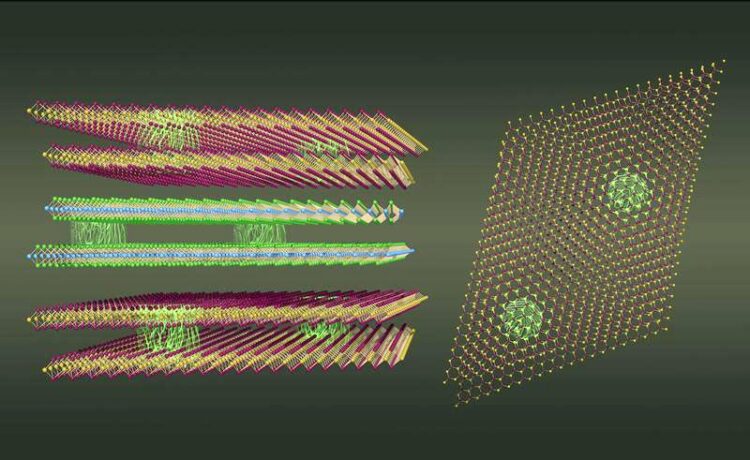Twisted van der Waals materials as a new platform to realize exotic matter

Twisted van der Waals materials offer enormous potential for fundamental research, materials science and quantum technologies.
Jörg Harms / MPSD
Researchers from the Max Planck Institute for the Structure and Dynamics of Matter (MPSD) in Hamburg, RWTH Aachen University (both in Germany), the Flatiron institute as well as Columbia University (both in the USA) and part of the Max Planck – New York City Center for Non-equilibrium Quantum Phenomena have provided a fresh perspective on the potential of twisted van der Waals materials for realising novel and elusive states of matter and providing a unique materials-based quantum simulation platform.
The team of researchers has laid out an exciting road map for the vibrant field of twisted van der Waals materials, reviewing the rapid progress made recently and adding their unique vision of intriguing avenues of future research to be completed.
In their work, now published in Nature Physics, the team demonstrates that the future of twisted van der Waals materials is bright – both in terms of fundamental science as well as their potential applications in materials science and quantum information technologies. Twisted van der Waals materials consist of stacked layers of two-dimensional systems at a relative rotation angle. They are shown to provide a versatile toolbox to realize many highly sought-after quantum model systems, which exhibit exotic and – so far – elusive phases of mater of potential relevance to material science and quantum technologies. Hence those twisted van der Waals materials define a materials-based quantum simulator.
This is particularly exciting as twisted van der Waals materials offer tantalising opportunities to provide clean systems which are extremely well controlled by the twist angle, stacking sequence, substrate or gating techniques.
However, this article demonstrates that the potential of twisted van der Waals materials even multiplies when brought together with other blossoming fields of condensed matter and quantum technology research. The potential for extensions is vast, with even more rich physics to be uncovered by, for example, by investigating the interaction of non-equilibrium states or cavities with the already promising van der Waals materials
“One of the strengths of these novel materials is that they provide an unprecedented level of tunability,” says lead author Dante Kennes. “This allows us to effectively realize many of the different lattice quantum models, which have taken center stage in the last few decades in the field of condensed matter research.”
Thus, exotic phases of matter, such as the elusive spin-liquid phase or systems with topological properties favorable to quantum technologies might be on the horizon. “We are really at the beginning of an intriguing journey to explore the vast amount of chemical and physical combinations in the field,” co-author Lede Xian reports about his recent work. ” Many more exciting discoveries, some of which we outline in our work, will follow”, adds fellow author Martin Claassen.
Twisted van der Waals materials offer a wonderful and formidable experimental challenge due to their complexity. They also open up completely new routes of manipulating and controlling quantum materials, according to Ángel Rubio, the director of the MPSD’s Theory Department: “These materials let us unravel new phases of matter and promise a wide range of exciting applications in quantum technologies. We have just touched the surface of those possibilities in this perspective article and we can expect many more surprises in this exciting research journey.”
As this work illustrates, the ratio between questions answered and interesting questions to be addressed in the future makes this a particularly promising and vibrant research field, adds Ángel Rubio: “This plethora of exciting new phenomena can be enlarged further when considering driving those systems out of equilibrium or embedding them in optical cavities. Many interesting phenomena are waiting to be unraveled ahead of us!”
Wissenschaftliche Ansprechpartner:
Dante Kennes, lead author: Dante.Kennes@rwth-aachen.de
Originalpublikation:
https://www.nature.com/articles/s41567-020-01154-3
Weitere Informationen:
https://www.mpsd.mpg.de/503053/2021-02-kennes-vanderwaals?c=17189
Media Contact
All latest news from the category: Physics and Astronomy
This area deals with the fundamental laws and building blocks of nature and how they interact, the properties and the behavior of matter, and research into space and time and their structures.
innovations-report provides in-depth reports and articles on subjects such as astrophysics, laser technologies, nuclear, quantum, particle and solid-state physics, nanotechnologies, planetary research and findings (Mars, Venus) and developments related to the Hubble Telescope.
Newest articles

Innovative 3D printed scaffolds offer new hope for bone healing
Researchers at the Institute for Bioengineering of Catalonia have developed novel 3D printed PLA-CaP scaffolds that promote blood vessel formation, ensuring better healing and regeneration of bone tissue. Bone is…

The surprising role of gut infection in Alzheimer’s disease
ASU- and Banner Alzheimer’s Institute-led study implicates link between a common virus and the disease, which travels from the gut to the brain and may be a target for antiviral…

Molecular gardening: New enzymes discovered for protein modification pruning
How deubiquitinases USP53 and USP54 cleave long polyubiquitin chains and how the former is linked to liver disease in children. Deubiquitinases (DUBs) are enzymes used by cells to trim protein…


